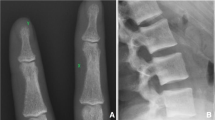Abstract
Studies of the effect of parathyroidectomy (PTX) on bone turnover in patients with the combination of primary hyperparathyroidism (PHPT) and Paget's disease (PD) are largely limited to case reports. The etiology of the combination is disputed. We report 30 patients and their biochemical (n = 17) and histomorphometric (n = 4) responses to PTX in 18. All 18 patients except one had a post-PTX fall in plasma alkaline phosphatase (pAP). There was a significant positive correlation between the degree of post-PTX fall in pAP and both the preoperative plasma total corrected calcium (CaC) (P < 0.01) and serum ionized calcium (P < 0.05). For the patients with CaC levels >3.0 mmol/liter, the mean % fall in pAP was 68% of pretreatment (to 32%). For those with CaC levels ≥2.68 mmol/liter the fall in pAP was >18%. Of 12 literature cases treated by PTX and followed up, 11 had a postoperative fall in pAP (range 6–83%). Pretreatment bone biopsies (n = 6) could not be distinguished from uncomplicated PD. No significant histomorphometric changes were documented postoperatively in the four patients studied; however, % fibrotic surfaces declined in each of the four. Of the 18 patients, only one had radiologic subperiosteal erosions preoperatively; none had clinical tetany postoperatively—thus distinguishing this combination of diseases from severe PHPT bone disease—a situation easily biochemically confused with this combination. The sex distribution of 2.75:1 F/M in this series resembles reported ratios in pure PHPT of 2.37:1, unlike the ratios found in pure PD (0.49–1.01:1). The prevalence of PHPT in PD is 2.2–6.0% (mean 4.4%) in 1836 patients. In our series, 73% of patients with both diseases were females >60 years of age. In population studies >60 years, PHPT was present in 3% of women and 1% of men. Hypercalcemia in PD is frequently attributed to immobilization. As part of this study, we examined 184 patients referred with PD for the existence of, and cause of hypercalcemia. Of this group, 21 were hypercalcemic, 19 (90%) of whom had PHPT; none had immobilization hypercalcemia. In patients with both disorders, the indications for PTX should include the potential post-PTX improvement in pagetic biochemistry and symptoms. The sex distribution (resembling pure PHPT) and the similar prevalence of PHPT in Paget's, and in the elderly population, support the likelihood, in most cases, that these two common diseases are associated by chance.
Similar content being viewed by others
Author information
Authors and Affiliations
Additional information
Received: 20 November 1998 / Accepted: 23 April 1999
Rights and permissions
About this article
Cite this article
Gutteridge, D., Gruber, H., Kermode, D. et al. Thirty Cases of Concurrent Paget's Disease and Primary Hyperparathyroidism: Sex Distribution, Histomorphometry, and Prediction of the Skeletal Response to Parathyroidectomy. Calcif Tissue Int 65, 427–435 (1999). https://doi.org/10.1007/s002239900728
Published:
Issue Date:
DOI: https://doi.org/10.1007/s002239900728




